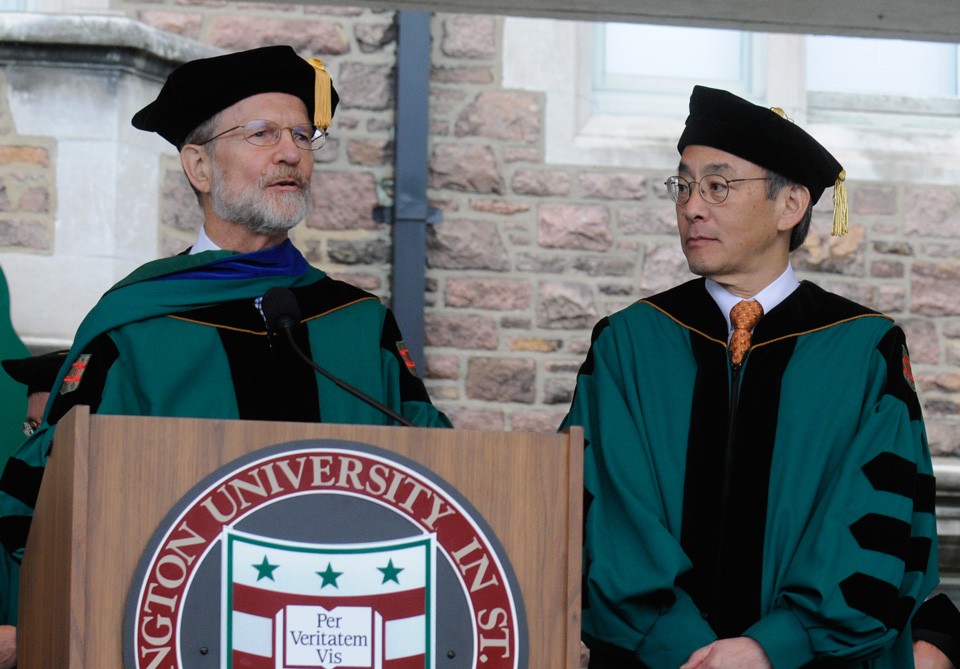
Steven Chu
U.S. Secretary of Energy Steven Chu, PhD, was selected to give the 149th Commencement address at Washington University in St. Louis. Chu received an honorary doctor of science degree in 2010.

“I am delighted that Steven Chu has agreed to serve as Washington University’s 2010 Commencement speaker,” Wrighton said. “One of the greatest challenges facing us is to develop energy resources that are affordable, abundant and environmentally sustainable. The opportunity for our graduates to hear from our nation’s leader on energy is a tremendous honor. The fact that Dr. Chu has a special connection to Washington University — his father served on the faculty in our School of Engineering & Applied Science — makes his participation even more meaningful.”
Chu, a Nobel laureate and a strong advocate for alternative energy sources, received an honorary doctor of science degree during the ceremony.
Chu won the 1997 Nobel Prize in physics with William Phillips, PhD, and Claude Cohen-Tannoudji, PhD, for figuring out how to use laser beams and extreme cold to stop single atoms in their tracks, allowing them to be studied in greater detail.
Strategizing methods to prevent the depletion of natural resources
He has devoted his recent scientific career to the search for new solutions to energy challenges and stopping global climate change. He was appointed by President Barack Obama as the 12th secretary of energy and sworn into office on Jan. 21, 2009.
Chu is charged with helping implement Obama’s agenda to invest in alternative and renewable energy, end the nation’s addiction to foreign oil, address the global climate crisis and create millions of new jobs.
Prior to his Cabinet-level appointment, Chu was director since 2004 of the Department of Energy’s Lawrence Berkeley National Lab, where he successfully led its pursuit of new alternative and renewable energies. He also was a professor of physics and molecular and cell biology at the University of California, Berkeley.
Chu was born in St. Louis in 1948, while his father taught chemical engineering at Washington University.
“Education in my family was not merely emphasized, it was our raison d’être,” he wrote in an autobiography for Les Prix Nobel, The Nobel Prizes 1997, Editor Tore Frängsmyr, [Nobel Foundation], Stockholm, 1998.
“When the dust had settled, my two brothers and four cousins collected three MDs, four PhDs and a law degree. I could manage only a single advanced degree” (a doctorate in physics from the University of California, Berkeley, in 1976).
Chu, who went to high school in New Jersey, earned both a bachelor’s degree in mathematics and in physics from the University of Rochester in 1970. After earning a doctorate at Berkeley, he worked there first as a postdoctoral fellow and then as an assistant professor.
He left in the fall of 1978 to pursue a career at AT&T’s Bell Laboratories.
Chu recalls his time at Bell Labs as being like the Disney character Mary Poppins: “practically perfect in every way,” he wrote in his autobiography for Les Prix Nobel. “Bell Labs management supplied us with funding, shielded us from extraneous bureaucracy, and urged us not to be satisfied with doing merely ‘good science.’
“My department head, Peter Eisenberger, told me to spend my first six months in the library and talk to people before deciding what to do. A year later during a performance review, he chided me not to be content with anything less than ‘starting a new field.’ I responded that I would be more than happy to do that, but needed a hint as to what new field he had in mind.”
It was at Bell Labs that he did the work with laser cooling that would later win him the Nobel Prize in physics.
Expanding the scope of scientific research with new discoveries
Chu left Bell labs in 1987 to join Stanford University’s faculty. While at Stanford, he expanded his research interests to include polymer physics and biophysics.
“I set about to manipulate individual DNA molecules with the so-called ‘optical tweezers’ by attaching micron-sized polystyrene spheres to the ends of the molecule. My idea was to use two optical tweezers introduced into an optical microscope to grab the plastic handles glued to the ends of the molecule,” he wrote for Les Prix Nobel.
“By 1990, we could see an image of a single, fluorescently labeled DNA molecule in real time as we stretched it out in water. Using our new ability to simultaneously visualize and manipulate individual molecules of DNA, my group began to answer polymer dynamics questions that have persisted for decades.”
Chu, who was the Theodore and Frances Geballe Professor of Physics and Applied Physics at Stanford, twice served as chair of its physics department and together with other professors initiated the Bio-X program, which focuses on interdisciplinary research in biology and medicine.
The recipient of many honors and awards, Chu is a member of the National Academy of Sciences, the American Philosophical Society, the Chinese Academy of Sciences, Academica Sinica and the Korean Academy of Sciences and Technology.
He is married to Jean Chu, PhD, who holds a doctorate in physics from Oxford University. He has two grown sons by a previous marriage.